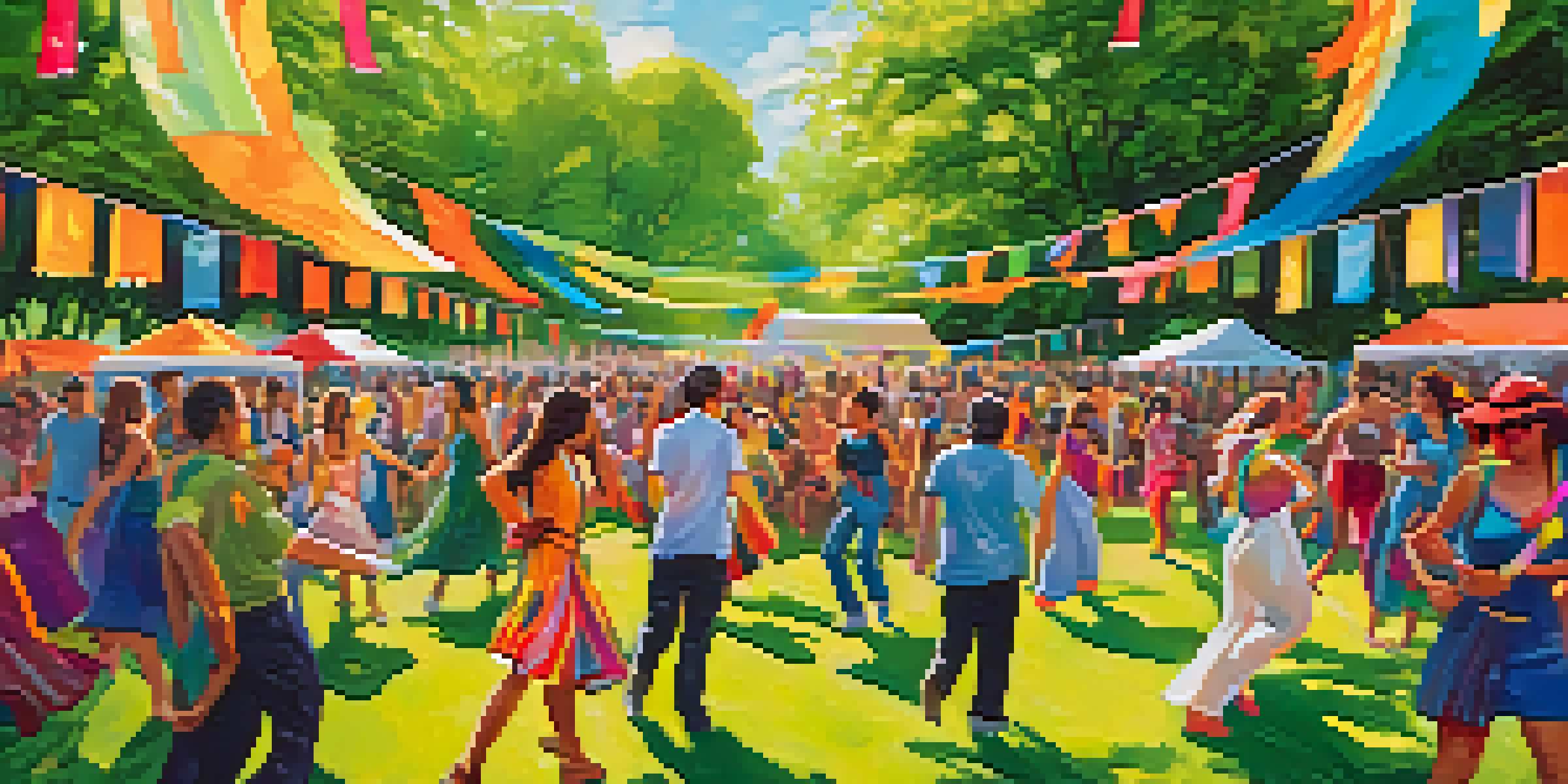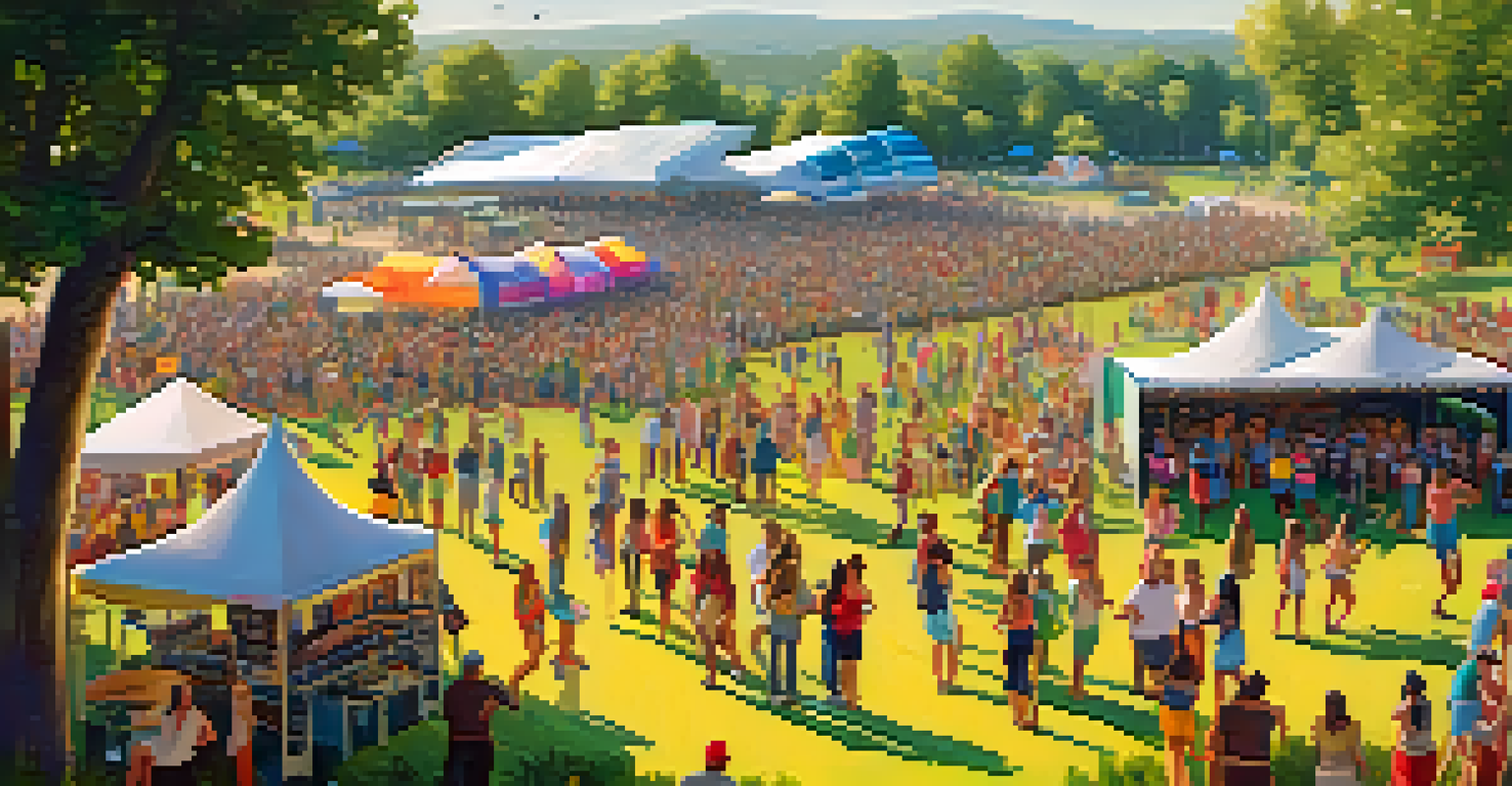Dance Festivals: A Platform for Environmental Awareness

Dance Festivals: A Celebration of Movement and Community
Dance festivals are vibrant gatherings that bring people together through the joy of movement and music. They create an atmosphere where communities can unite, share experiences, and celebrate diversity. This shared love for dance often fosters a sense of belonging, encouraging attendees to connect not only with each other but also with the environment.
Dance is the hidden language of the soul.
As participants immerse themselves in the rhythm, they often find themselves surrounded by nature, whether it's an open field or a scenic park. This proximity to the natural world can spark a deeper appreciation for the environment. The communal spirit of dance acts as a catalyst for attendees to engage in conversations about sustainability and eco-friendly practices.
Ultimately, dance festivals are more than just a showcase of talent; they serve as a platform for collective awareness. By blending artistry with activism, these events inspire attendees to reflect on their impact on the planet while enjoying the beauty of movement.
The Role of Dance Festivals in Environmental Advocacy
Many dance festivals now incorporate themes of environmental awareness, using their platform to highlight critical issues like climate change and biodiversity loss. Organizers often invite speakers and activists to discuss these challenges, educating audiences on how they can contribute positively. This fusion of art and activism makes sustainability a key part of the festival experience.

For example, some festivals have implemented waste reduction strategies, encouraging participants to minimize single-use plastics and promoting recycling. By showcasing eco-friendly vendors and sustainable practices, they set a standard for attendees to follow, both at the festival and in their everyday lives. This proactive approach helps cultivate a culture of responsibility among festival-goers.
Dance Festivals Foster Community Spirit
These vibrant gatherings unite people through movement and music, promoting a sense of belonging and connection.
Additionally, dance festivals often partner with local environmental organizations to amplify their message. This collaboration not only benefits the community but also strengthens the festival's commitment to sustainability. When attendees see these partnerships in action, it reinforces the idea that collective efforts can lead to meaningful change.
Innovative Practices in Eco-Friendly Festival Planning
Dance festivals are increasingly adopting innovative strategies to reduce their environmental footprint. From renewable energy sources powering the stages to biodegradable materials used in food service, the focus on sustainability is palpable. These changes not only enhance the festival experience but also set an example for other events to follow.
The earth does not belong to us: we belong to the earth.
For instance, some festivals have begun to utilize solar panels to power their sound systems and lighting. This not only cuts down on carbon emissions but also educates attendees about renewable energy options. When festival-goers see these technologies in action, it inspires them to consider similar solutions in their own lives.
Furthermore, many festivals are now implementing carpooling incentives and promoting public transportation options. This approach reduces traffic congestion and lowers carbon footprints, making it easier for attendees to choose eco-friendly travel methods. By prioritizing sustainable transportation, festivals can significantly impact their overall environmental impact.
Engaging Attendees Through Interactive Workshops
Workshops at dance festivals can play a crucial role in promoting environmental awareness. These interactive sessions often cover topics such as sustainable living, eco-friendly practices, and the importance of conservation. By engaging attendees in hands-on learning, festivals can inspire action beyond the event itself.
For example, workshops might teach participants how to create their own eco-friendly dance attire or how to repurpose materials into art. Such activities not only foster creativity but also highlight the importance of reducing waste. When attendees see the practical applications of sustainability, they are more likely to embrace these practices in their daily lives.
Sustainability is Key Focus
Dance festivals increasingly prioritize environmental advocacy, incorporating eco-friendly practices and educating attendees on sustainability.
Moreover, these workshops provide a space for dialogue and collaboration among attendees. As participants share their ideas and experiences, they build a community that values both dance and environmental stewardship. This sense of camaraderie can lead to lasting connections and collective action long after the festival ends.
Artistic Expression as a Tool for Environmental Messaging
Dance itself can serve as a powerful medium for conveying messages about the environment. Choreographers often use their craft to tell stories that highlight ecological challenges, encouraging audiences to reflect on their relationship with nature. This blend of art and advocacy makes environmental issues more accessible and relatable.
Additionally, visual art installations at festivals can further enhance this message. Artists might create pieces using recycled materials or depict themes of nature in their work, fostering a dialogue about sustainability. These installations not only beautify the festival space but also serve as a visual reminder of the importance of protecting our planet.
When attendees engage with these artistic expressions, they are more likely to internalize the messages being conveyed. This emotional connection can inspire individuals to take action, whether that means reducing their environmental impact or advocating for policy changes. In this way, dance festivals become a canvas for both creativity and consciousness.
Building a Community of Eco-Conscious Dancers
Dance festivals often create a unique community of like-minded individuals who prioritize environmental sustainability. This community fosters connections and encourages participants to share their eco-friendly practices and challenges. By coming together, they can inspire one another to adopt more sustainable habits.
For instance, many attendees form groups focused on environmental advocacy, organizing clean-up events or tree-planting initiatives after the festival. This sense of camaraderie extends beyond the festival itself, creating a network of individuals committed to making a difference. As these connections deepen, the community becomes a powerful force for positive change.
Art as a Medium for Change
Through dance and visual art, festivals convey powerful messages about environmental challenges, inspiring action among participants.
Moreover, social media plays a vital role in maintaining this community. Attendees often share their experiences, tips, and initiatives online, further amplifying their collective impact. By leveraging digital platforms, they can reach a wider audience, encouraging even more people to join the movement toward sustainability.
The Future of Dance Festivals and Environmental Awareness
As the world becomes more aware of environmental issues, dance festivals are likely to continue evolving in their approach to sustainability. The growing demand for eco-friendly practices means that organizers will seek new ways to innovate and engage their audiences. This evolution could lead to even more impactful collaborations with environmental organizations and artists.
In the coming years, we may see more festivals adopting comprehensive sustainability plans that address everything from waste management to energy consumption. This proactive approach can set a new standard for events across the globe, encouraging others to follow suit. The ripple effect of these changes could lead to a significant shift in how festivals are perceived and organized.

Ultimately, the future of dance festivals lies in their ability to inspire and unite people around a common cause. By continuing to prioritize environmental awareness, these events can cultivate a culture of sustainability that resonates not just within the festival grounds, but also in the hearts and minds of attendees long after the music fades.